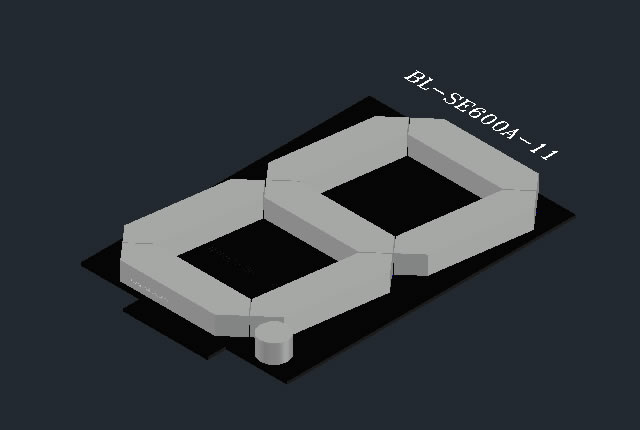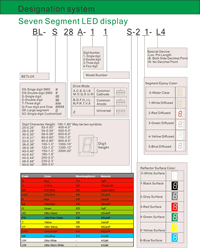Display Charcter Color
Series No:
Weight:(g/pcs)
Dimension:(mm)
Character Height: (inch)
Specification:
Inquiry
Description:
“Brilliant Display Power: The Versatility of 6-Inch Large 7 Segment LED Displays”
Introduction
In the field of digital signage, measurement instruments, and industrial control systems, clarity and visibility are everything. Among the most effective and reliable tools for numeric visualization are large 7 segment displays. The 6-inch single-digit big segment display is designed for long-distance readability, robust performance, and easy integration. Its large format makes it ideal for applications that require instant data recognition, even in bright or outdoor environments.
Commonly integrated with microcontrollers such as 7 segment display Arduino systems, these displays are essential in sectors where real-time numeric output is critical. From public information boards to production monitoring systems, the led segment design provides durability, brightness, and unmatched energy efficiency.
This article will explore the technical features, applications, benefits, and user experiences of the 6-inch single-digit display, highlighting why it remains a cornerstone of industrial and commercial digital communication.
Features of the 6-Inch Single-Digit Large 7 Segment Display
The large 7 segment display is purpose-built to deliver clear, bright, and long-lasting performance. Each digit is made up of seven individually controlled LED segments arranged in the shape of the number “8.” This modular design allows for the display of all numerical digits (0–9) and select characters. The led segment construction ensures uniform illumination, reliability, and ease of control.
Key Features:
-
Massive 6-Inch Digit Size:
With a large and bold numeric format, the display provides clear readability from distances of up to 30 meters. Perfect for dashboards, production counters, and scoreboards. -
High Brightness and Contrast:
The LEDs emit high-intensity light, making the display visible even in bright ambient conditions or outdoor installations. -
Energy Efficiency:
Despite their brightness, these 7 seg LED modules consume minimal power thanks to advanced LED technology, making them eco-friendly and cost-effective. -
Durable Construction:
Encased in robust housing, the display is resistant to vibration, dust, and moisture—ideal for harsh industrial environments. -
Flexible Control Options:
Compatible with 7 segment display Arduino configurations, these displays can easily be programmed and controlled using standard driver ICs or microcontrollers.
Applications Across Industries
The 6-inch large 7 segment display is one of the most versatile display components in the electronics industry. Its readability, robustness, and compatibility with digital systems make it invaluable across numerous applications.
-
Industrial Control Systems:
In factories and workshops, led segment displays are commonly used for showing real-time production counts, temperature readings, and voltage outputs. Their size ensures that information is visible even from across the production floor. -
Public Information Displays:
Transportation systems, gas stations, and retail stores use these displays for showing pricing, arrival times, or countdowns. The 7 seg LED design guarantees consistent and easily recognizable digits, even from a distance. -
Sports and Event Scoreboards:
The large format and bright illumination make these displays ideal for scoreboards, timers, and lap counters in both indoor and outdoor environments. -
Energy and Power Monitoring Equipment:
7 segment display Arduino setups are often used to build custom monitoring systems that utilize these 6-inch displays to represent output power, current, or system status. -
Medical and Laboratory Equipment:
Laboratories integrate these displays into devices that require precision readings visible to technicians from multiple angles and distances.
Benefits of Using 6-Inch Large 7 Segment Displays
The large 7 segment display offers numerous advantages that make it a superior choice over smaller or traditional numeric display technologies.
-
Outstanding Visibility:
The 6-inch height ensures the digits are visible from afar, which is crucial in industrial environments where operators need to read information quickly and accurately. -
Wide Viewing Angle:
The led segment structure provides consistent brightness across a broad viewing angle, maintaining readability regardless of positioning. -
Ease of Integration:
These displays are easy to interface with microcontrollers, particularly 7 segment display Arduino setups, enabling fast development of display systems and prototypes. -
Extended Operational Life:
Designed to last tens of thousands of hours, the 7 seg LED technology ensures long-term stability and minimal maintenance. -
Versatile Mounting Options:
The display can be mounted vertically or horizontally, allowing flexible placement in dashboards, walls, or control panels.
Case Studies: Practical Implementations
Case Study 1 – Industrial Production Line Display
A manufacturing plant implemented the 6-inch large 7 segment display in its real-time production monitoring system. By integrating the display with an Arduino-based controller, the plant automated its counter display for daily unit production. The result was a 40% improvement in process transparency and efficiency, as employees could instantly view output status from across the floor.
Case Study 2 – Public Transportation System
A transport operator deployed led segment displays in bus stations to show departure times and route numbers. The bright and weather-resistant displays performed reliably under outdoor conditions, even during daylight. This improved passenger satisfaction and reduced service inquiries by 25%.
Case Study 3 – Sports Facility Scoreboards
A regional stadium upgraded to 6-inch 7 seg LED scoreboards for better spectator visibility. The displays, controlled via an Arduino microcontroller, provided seamless real-time scoring and timing with minimal maintenance requirements.
User Testimonials
Alex Turner, Senior Automation Engineer (USA):
“The large 7 segment display has become our go-to component for factory counters. It’s reliable, easy to integrate, and visible even from long distances. We’ve significantly improved operator efficiency.”
Laura Kim, Product Development Manager (UK):
“We used the 6-inch 7 segment display Arduino setup for an energy monitoring product. Its brightness and efficiency exceeded our expectations. Plus, it’s incredibly easy to program.”
Satoshi Nakamura, Display System Integrator (Japan):
“Our outdoor displays needed durability and brightness. The large 7 seg LED modules delivered consistent performance, even in extreme weather conditions.”
Conclusion
The 6-inch single-digit large 7 segment display represents the perfect blend of visibility, durability, and adaptability. Its bold design ensures long-distance readability, while its compatibility with 7 segment display Arduino systems offers engineers limitless customization possibilities. Across industries—from manufacturing to public infrastructure—this led segment technology delivers the reliability and clarity that modern electronic displays demand.
For professionals seeking a robust, energy-efficient, and high-impact numeric display, the 7 seg LED system remains a trusted and future-ready choice. Harness its capabilities to elevate your next project and ensure your data is seen clearly, every time.

big segment display
Features:
- Large digit size: 5.00 inch
- Digit height: 122mm
- Dimensions: 100mm x 150mm
- Includes a single decimal point and a comma
- Each segment contains a single LED chip
- Offers the option of common anode or common cathode
- Designed for low current operation
- Provides excellent character appearance
- Delivers high light output for visibility
- Easy mounting on PC boards or sockets
- IC compatible for seamless integration
- Multicolor options available for diverse display needs
- Luminous intensity categorized for consistent brightness
- Technically rugged for durability and reliability
- Standard design features a gray surface with white segments
- Compliant with RoHS standards for environmental responsibility
Applications:
- Industrial scoreboards for displaying production metrics and targets
- Stadium displays for showcasing scores, game time, and advertisements
- Large-scale timers and clocks for public areas and events
- Public information displays for conveying important messages and announcements
- Railway and airport displays for departure/arrival times and schedule information
- Outdoor advertising displays for promoting products and services in high-visibility areas
- Panel meters for industrial applications, such as monitoring equipment status and process variables
Electrical-optical characteristics:
Package configuration & Internal circuit diagram
Obtain 3D specification files
To examine all 3D specifications, save the files to your local drive and open them with your 3D application.
Lens colors in 3D files are solely for visual representation; consult the Datasheet for accurate lens type and color information.
In the event of a mismatch, the dimensions in the datasheet take precedence over the 3D specifications.
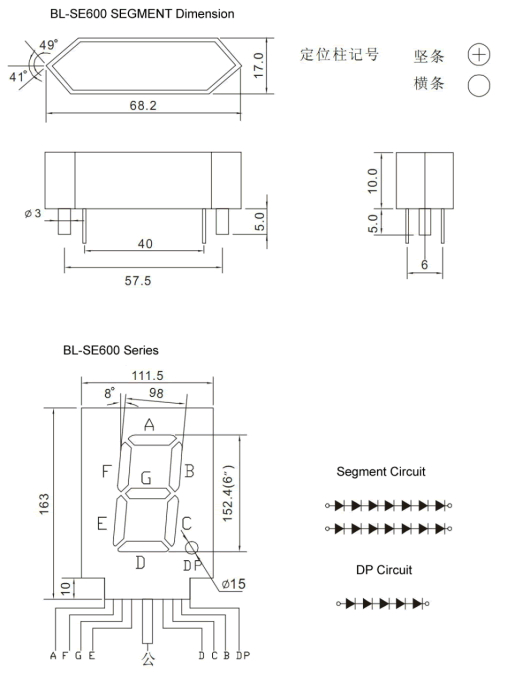
All dimensions are in millimeters(inches)
Tolerance is +-0.25(0.01″) unless otherwise note
Specifications are subject to change without notice.
Partno description:
More information
Reflector Surface color (1st number)/ Segment Lens color (2nd number):
| Number | 0 | 1 | 2 | 3 | 4 | 5 |
| Ref Surface Color | White | Black | Gray | Red | Green | |
| Epoxy Color | Water clear | White diffused | Red Diffused | Green Diffused | Yellow Diffused |
Absolute maximum ratings (Ta= 25°C)
| Parameter | S | D | UR | E | Y | G | Unit | |
| Forward Current IF | 25 | 25 | 25 | 25 | 25 | 30 | mA | |
| Power Dissipation Pd | 60 | 60 | 60 | 60 | 60 | 65 | mW | |
| Reverse Voltage VR | 5 | 5 | 5 | 5 | 5 | 5 | V | |
| Peak Forward Current IPF (Duty 1/10 @1KHZ) | 150 | 150 | 150 | 150 | 150 | 150 | mA | |
| Operation Temperature TOPR | -40 to +80 | °C | ||||||
| Storage Temperature TSTG | -40 to +85 | °C | ||||||
| Lead Soldering Temperature TSOL | Max.260+ 5°C for 3 sec Max. ( 1.6mm from the base of the epoxy bulb) | °C | ||||||
Absolute maximum ratings (Ta= 25°C)
| Parameter | UHR | UE | YO | UY | UG | PG | UB | UW | Unit |
| Forward Current IF | 30 | 30 | 30 | 30 | 30 | 30 | 30 | 30 | mA |
| Power Dissipation Pd | 75 | 65 | 65 | 65 | 75 | 110 | 120 | 120 | mW |
| Reverse Voltage VR | 5 | 5 | 5 | 5 | 5 | 5 | 5 | 5 | V |
| Peak Forward Current IPF (Duty 1/10 @1KHZ) | 150 | 150 | 150 | 150 | 150 | 150 | 100 | 100 | mA |
| Operation Temperature TOPR | -40 to +80 | °C | |||||||
| Storage Temperature TSTG | -40 to +85 | °C | |||||||
| Lead Soldering Temperature TSOL | Max.260+ 5°C for 3 sec Max. ( 1.6mm from the base of the epoxy bulb) | °C | |||||||
Related Information
Applied for:

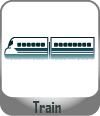

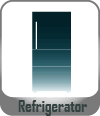
1. Application
The Seven Segment LED is widely applied for ordinary electronic equipment (such as office equipment,
communication equipment and household applications). Checking with BETLUX’s Sales in
advance for information on applications in which exceptional reliability is required, particularly
when the failure or malfunction of the LEDs may directly jeopardize life or health (such as in
aviation, transportation, traffic control equipment, medical and life support systems and safety
devices).
2. Storage
The storage ambient for the Seven Segment LED should not exceed 30℃ temperature or 70% relative humidity.
For extended storage out of their original packaging, it is recommended that the Seven Segment LEDs be stored
in a sealed container with appropriate desiccant, or in a desiccator with nitrogen ambient.
3. Cleaning
Avoid using any unspecified chemical solvent to clean LED . For example, Trichloroethylene, Chlorosen, Acetone, and Diflon S3MC.
Any cleaning method can only be taken under normal temperature in one minute or less if it is required.
Use water to clean the Seven Segment LED if necessary under room temperature
dry it immediately after that.
4.Forming
Any unsuitable stress applied to the epoxy may break bonding wires in LED
Any forming on lead pin must be done before soldering, not during or after soldering.
Avoid applying any stress to resin in order to prevent the epoxy fracture and break on bonding wire.
While forming, please use a tie bar cut or equivalent to hold or bend the pin.
2mm from the base of resin is the minimum distance for the place bending the lead pin.
Avoid bending the lead pin at the same point twice or more.

Soldering
When soldering, leave a minimum of 2mm clearance from the base of the base of the lens to the soldering point. Dipping the lens into the solder must be avoided.
Do not apply any external stress to the lead frame during soldering while the LED is at high temperature.
Recommended soldering conditions:
| IR Reflow Soldering (for SMD display) | Wave Soldering | Soldering Iron | |||
| Pre-Heat | 150-180°C | Pre-Heat | 100°C Max. | Temperature | 300°C Max. |
| Pre-Heat Time | 120sec Max. | Pre-Heat Time | 60sec Max. | ||
| Peak Temperature | 260°C Max. | SolderWave | 260°C Max. | Soldering Time | 3sec Max.(one time only) |
| Soldering Time | 10 sec Max. | Soldering Time | 5sec Max. | ||
Note: Excessive soldering temperature and/or time might result in deformation of the LED lens or failure of the LED
ESD(Electrostatic Discharge)
Static Electricity or power surge will damage the LED.
Suggestions to prevent ESD (Electrostatic Discharge):
n Use a conductive wrist band or anti-electrostatic glove when handling these LEDs
n All devices, equipment, and machinery must be properly grounded
n Work tables, storage racks, etc. should be properly grounded
n Use ion blower to neutralize the static charge which might have built up on surface of the LED’s
plastic lens as a result of friction between LEDs during storage and handling
ESD-damaged LEDs will exhibit abnormal characteristics such as high reverse leakage current,
low forward voltage, or “no light on” at low currents. To verify for ESD damage, check for “light on”
and Vf of the suspect LEDs at low currents.
The Vf of “good” LEDs should be>2.0V@0.1mA for InGaN product and >1.4V@0.1mA for AlInGaP
product.

LED dirve IC by Maxim Integrated
MAX6959 4½-Digit LED Display Driver
MAX6958 4½-Digit LED Display Driver
MAX6955 7-, 14-, 16-Segment LED Display Driver
MAX6956 LED Static Display Driver and I/O Port
MAX6954 7-, 14-, 16-Segment LED Display Driver
MAX6952 5 x 7 Matrix LED Display Driver
MAX6957 LED Static Display Driver and I/O Port
MAX6950 5-Digit LED Display Driver
MAX6951 8-Digit LED Display Driver
ICM7212 4-Digit LED Driver
ICM7212A 4-Digit LED Driver
ICM7212AM 4-Digit LED Driver
ICM7212M 4-Digit LED Driver
ICM7218A 8-Digit LED Driver
ICM7218B 8-Digit LED Driver
ICM7218C 8-Digit LED Driver
ICM7218D 8-Digit LED Driver
MAX7221 8-Digit LED Display Driver
MAX7219 8-Digit LED Display Driver
When selecting power for LED systems, it’s essential to understand several key parameters to ensure safe operation, longevity, and optimal performance. Here are some steps and considerations for LED power selection:
- Determine the Forward Voltage (Vf) of the LED(s):
Each LED has a forward voltage, which is the voltage at which the LED operates when the current is flowing through it. This value can typically be found in the LED’s datasheet.
- Determine the Forward Current (If) of the LED(s):
The forward current is the current at which the LED is designed to operate. Running an LED at higher than its rated current can reduce its lifespan and increase the heat it produces.
- Decide on the Configuration:
Series Configuration: When LEDs are connected in series, the forward voltages add up, but the current remains the same.
Parallel Configuration: When LEDs are connected in parallel, the forward voltage remains the same, but the currents add up. This configuration can be risky because if one LED fails or has a slightly lower forward voltage, it can cause the other LEDs to draw more current.
Calculate Total Power Requirements:
Power (W) = Total Forward Voltage (V) x Total Forward Current (A)
For example, if you have three LEDs connected in series, each with a forward voltage of 3V and a forward current of 20mA, the total power requirement would be:
Power = (3V + 3V + 3V) x 20mA = 9V x 0.02A = 0.18W
- Select an Appropriate Power Supply:
- Voltage Rating: The power supply voltage should match or slightly exceed the total forward voltage of your LED configuration.
- Current Rating: The power supply’s current rating should meet or exceed the total forward current of your LED configuration.
- Safety Margin: It’s a good practice to select a power supply that can provide at least 20% more power than your calculated requirement. This ensures the power supply isn’t operating at its maximum capacity, which can extend its life and ensure safer operation.
- Consider Additional Features:
- Dimming Capability: If you want to control the brightness of your LEDs, choose a power supply with dimming capabilities.
- Overcurrent and Overvoltage Protection: To protect your LEDs, select a power supply with built-in protection mechanisms.
- Thermal Management: Ensure that the power supply has adequate cooling, especially if it will be enclosed or in a location with limited airflow.
- Regulation and Efficiency:A power supply with good regulation will maintain a consistent voltage output despite variations in the load. High efficiency ensures minimal power is wasted as heat.
- Physical Size and Form Factor:Depending on where you plan to place the power supply, its size and shape may be critical factors.
In summary, when selecting power for LED systems, understanding your LED’s requirements and the configuration you plan to use is essential. Then, pick a power supply that meets those needs with some added safety margin, keeping in mind any additional features or constraints relevant to your project.
Here are some well-regarded brands in the industry:
- Mean Well: One of the most recognized brands in the LED power supply industry, Mean Well offers a wide range of products suitable for both indoor and outdoor applications. Their units often come with features like overcurrent protection, dimming capabilities, and high efficiency.
- Tridonic: A global leader in lighting technology, Tridonic offers LED drivers and power supplies that cater to various lighting solutions, from simple setups to advanced smart lighting systems.
- Philips Advance Xitanium: Philips is a well-known brand in the lighting industry, and their Xitanium series of LED drivers are known for reliability and performance. They cater to both indoor and outdoor LED applications.
- Osram: Another giant in the lighting industry, Osram offers a range of LED drivers and power supplies suitable for various applications, including architectural and street lighting.
- LIFUD: Specializing in LED drivers, LIFUD is known for its high-quality products that cater to both commercial and residential LED lighting solutions.
- MOSO: This brand offers a variety of LED drivers, especially for outdoor and industrial applications. Their products are known for durability and performance.
- TDK-Lambda: With a history in power electronics, TDK-Lambda offers a range of power supplies and LED drivers suitable for various applications, emphasizing reliability and advanced features.
